The Stolen Church of Glenford
Mary Angeles Armstrong | January 15, 2016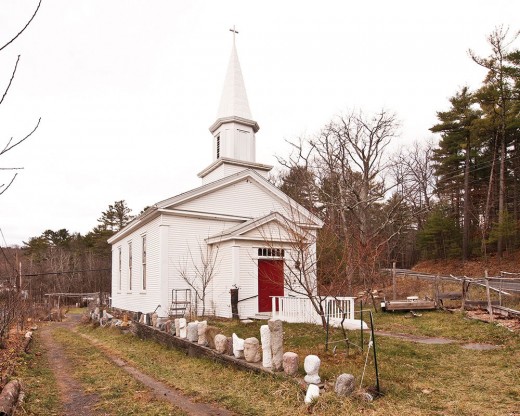
The exterior of the “Stolen Church of Glenford.” – DEBORAH DEGRAFFENREID
[Editor’s Note: This piece originally appeared on Chronogram.com.]
Every New Year’s Day for the past 14 years, Mor Pipman and Eric Hurliman have invited friends over for soup. It’s a tradition that began their first year of marriage. “We’d met and married in a whirlwind and then the holidays came,” Pipman remembers. “There was our wedding party, then Thanksgiving and office parties. It was parties, parties, parties—by New Year’s Eve we refused to go out. So we decided to stay home and make a pot of seafood bisque.”
Anyone who’s tasted Pipman’s “Much Mor” breads and jams or attended a Hudson Valley Sudbury School music night can guess the next part of this story: The soup was delicious. There was also plenty to share, and the next day, January 1st, they invited neighbors over for an impromptu lunch. This was in the East Village before gentrification and high-priced lattes, when Pipman and Hurliman were an integral part of the inter-generational, intercultural neighborhood. Those first guests were as diverse as the ingredients in that first pot of bisque. Pipman, a stone carver and ceramic sculptor, divided her time between teaching and organizing the local “M’finda Kalunga” community garden. “It was activism along with gardening,” Pipman describes, “and was all about creating community. We held classes where the neighborhood elders taught the kids gardening. We screened political movies. We celebrated everyone’s festivals—the Chinese harvest festival, Juneteenth, and the Sukkot.”
Their lives changed but the New Year’s soup tradition continued. Hurliman became an RN and they had two children, Ulysses and Zephyr. In 2007, their growing family and a rat infestation on their block sent them upstate looking for a new home, where they found an old church for sale outside Woodstock. Originally built in 1865, the former Methodist-Episcopalian church was one of 10 congregations displaced by the building of the Ashokan reservoir. It came to be known as “the stolen church of Glenford” when, in 1911, parishioners moved the church from the proposed reservoir basin to its current home in Glenford. “The story goes that it was stolen overnight,” Pipman says. “Of course, it wasn’t overnight. It takes time to move a church.”
According to local historian Bob Steuding, part of the church grounds stood within the boundaries of the Ulster and Delaware Railroad, something disgruntled congregants were quick to note when the city took control. The railroad president generously offered the church building to the congregation “if they could only cart it away”—and, to everyone’s surprise, they did. Oxen and dedicated congregants took five days to move the church from the Ashokan basin to the .9-acre triangle of donated land at the base of Ohayo Mountain. They then built a community hall (damaged and rebuilt after a 1935 fire) that eventually included a kitchen, a community meeting space, and a Sunday school annex. Over time, the local Methodist community, spread over three campuses, wanted to consolidate and expand. The limitations of the Glenford property became apparent. That’s when the Hurliman-Pipman family stepped in.
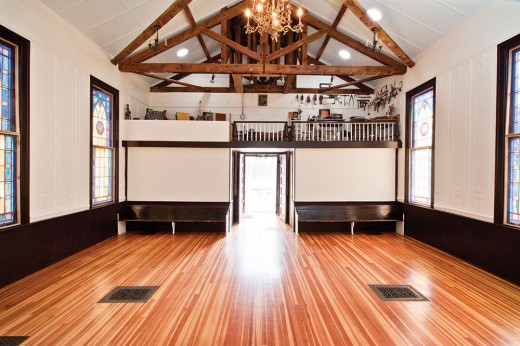
The interior of the “Stolen Church of Glenford.” – DEBORAH DEGRAFFENREID
Renovation Without a Plan
Although originally attracted to Kingston for its diversity, they were intrigued with the church after finding it online. “I don’t know what it was. There were dropped cottage-cheese ceilings and florescent lighting throughout both buildings. There was no real kitchen. All the windows were interior windows and there was no insulation.” Even so, they thought the church and its location might offer a new take on the familiar refrain of building community.
In the spring of 2008 they set up camp on the land and began the remodel. “Our priority was ecological,” Pipman tells me. “We weren’t concerned with aesthetics and we didn’t really have a plan.” They began by making the former community hall their living quarters. A kitchen from Green Demolitions, a nonprofit that recycles luxury kitchens and bathrooms, suited their needs perfectly. The honey-colored solid wood countertops, ornate cabinetry, and shelves laden with canned veggies are reminiscent of the late 19th century. Four-paned windows and wood doors, all bought secondhand from the Door Jamb in nearby Shokan, complete the vintage look. A large industrial stove adds a modern touch and is where Pipman, now a case worker for Hudson Valley Adoption Services, began her home-based business Much Mor Bread.
The church’s former hall was converted into a large family room. The drop-ceiling tiles, once removed, revealed an arched two-story ceiling, and new, higher windows infused the space with light. Extra material from the purchased kitchen transformed the former stage into an office and laundry area. Now, along the high walls, stained-glass art by Pipman’s sister and windows recycled from her parent’s house alternate with bookshelves and the back of the hall accommodates an oversize National Geographic world map. There’s even room for a baby grand piano in the corner. The bathroom, finished in white tile, includes an antique sink, clawfoot tub, and bidet, all salvaged from Zaborski’s architectural salvage in Kingston and refurbished by Pipman. The Sunday school annex was divided into two bedrooms and more office space. Eventually, a mudroom was added to the building’s entryway and a deck to the back side. Pipman dubs it all her “loft in the sticks.”
Low-impact Lifestyle
Hurliman has been working to further “green” their lifestyle. New solar panels supply most of the complex’s energy and also charge their plug-in hybrid. Hurliman built a large garden over the former church parking lot where they grow blueberry and raspberry bushes, grapes, and a fig tree along with a variety of vegetables. They hope a recently built pond will eventually provide them with fish. A recycled stone walkway leads through newly planted fruit trees to the original church.
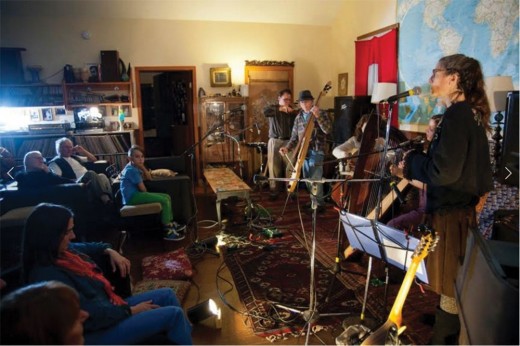
Mamalama performing at Hudson Valley Sudbury School Music Night in front of world map “stage.” – ROY GUMPEL
Although modernized, the former church sanctuary remains true to the original 19th-century design. As in the church hall, low ceilings were removed, exposing the original beams and bell tower, and solar tubes provide natural light. Insulation was added to the walls but the original dark wood carved paneling was refurbished or painstakingly replaced, and Pipman added antique chandeliers and a small centerpiece to the alter. Stained-glass windows, remnants of the building’s rich history, bathe the square chapel in blue and green light. Pipman’s small art studio sits above like a choir loft and the space regularly hosts public events—everything from book signings to art installations and musical performances (see sidebar).
True to tradition, this January 1st soup day will include a mix of guests. Over the years, the menu has grown to include a variety of soups as well as other dishes: cheese and bread, sometimes casseroles, and always plenty of wine and desserts. New Hudson Valley friends will join with current neighbors and even past church congregants to enjoy Pipman’s generous, tasteful creations. More than a few city people and former neighbors will make the drive, eventually crashing on one of the many couches spread across the former church hall. Every year, it’s a slightly new blend of that timeless ingredient: community. “It’s a pot of people,” Pipman tells me off-handedly. Indeed. And the Hurliman-Pipman clan will continue to stir. Hudson Valley Sudbury School Music Night
The last Friday of every month, the Old Glenford church’s sanctuary-turned-studio hosts an intimate house concert. Entrance costs five dollars and includes performances by two different acts. Music Night showcases an eclectic variety of acts, instruments, and musical styles, and has become the go-to listening room for local musicians introducing new material and anyone else who wants an affordable, high-quality night out. Performers at previous music nights include Deni Bonet, The Trapps, the Duke McVinnie Band, Lara Hope and the Ark-Tones, Robert Burke Warren, and Mark Black.
It was conceived by Pipman and local singer Carmen Senski as a benefit for the Hudson Valley Sudbury School. It’s a community Pipman came across serendipitously after her move to the area. While living in Manhattan, she had volunteered with the original Brooklyn Free School and was intrigued by the alternative-education movement. Pipman knew she wanted to take a similar approach with her own children’s education and remembered there was a related school in the Hudson Valley. “I knew there was a little school up here, but I couldn’t remember the name.” When she finally found it, and realized it was only three miles from her new house, she knew it was kismet. She enrolled her older son Ulysses, and younger son Zephyr was soon to follow. The family has been a part of the school community ever since and the parents feel their sons are thriving there.
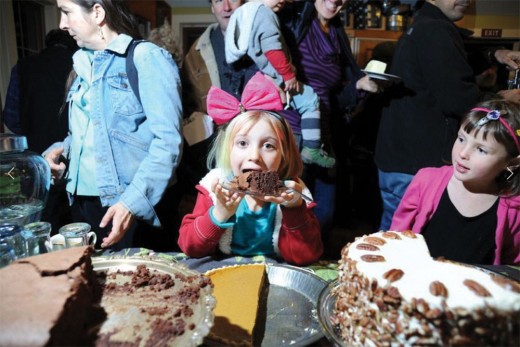
ROY GUMPEL
Music Night begins with Pipman serving a gourmet, seasonally inspired meal prepared in the former church kitchen. Besides featuring local sourced, sustainable produce, Mor’s dinners emphasize affordability. It’s $12 for a very full plate of food, less if you just want a side of something, and even less if you want an even smaller side. There’s always a wide variety of options, including vegetarian and vegan fare, and plenty of desserts. Kids are welcome, if they are the kind of kids who can sit through musical performances and you can BYOB if you respect the family atmosphere and intimate nature of the performance space.
On January 29, Whispering Trees and the Sweet Clementines will perform at HVSS Music Night. The old Glenford Church is 3 miles from Woodstock off Old Route 28. Doors open for dinner at 6pm and music begins at 7. All proceeds benefit the Hudson Valley Sudbury School. Hvssmusicnight.org.
Read On, Reader...
-
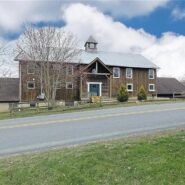
Jane Anderson | April 1, 2024 | Comment A Westtown Barn Home with Stained-Glass Accents: $799.9K
-
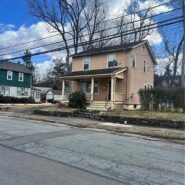
Jane Anderson | March 25, 2024 | Comment A c.1920 Three-Bedroom in Newburgh: $305K
-

-
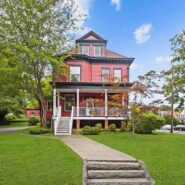
Jane Anderson | January 30, 2024 | Comment A Renovated Three-Story Beauty in Poughkeepsie: $695K
